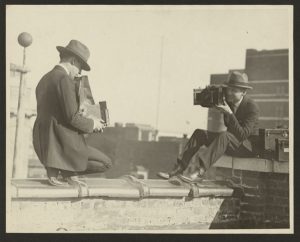The Paris Court of appeals has just published a decision which should be of interest to photographers anxious to defend their rights in France.
The Paris civil lower court (Tribunal de Grande Instance) had found in May 2015 that a photograph of Jimi Hendrix taken in February 1967 by British photographer Gered Mankowitz was not protected by French copyright (droit d’auteur) because it was not an original work of art. The court reasoned that the photographer had not shown which elements of the work protected by copyright were an imprint of his personality (traduire sa personnalité).
The photograph at stake represents Jimi Hendrix, facing the photographer, eyes slightly closed, arms crossed in front of the body, exhaling cigarette smoke. It was chosen by a French e-cigarette company to be featured in its advertising campaign, inside its two stores and online, without seeking permission of the author or the owner of the copyright, Bowstir Ltd, the company to which Mr. Mankowitz had assigned his patrimonial rights to the photography. Both filed suit in France. Bowstir claimed copyright infringement and Mr. Mankowitz claimed droit moral infringement, but they lost because they had not been able to prove, according to the Paris lower court, that the photograph was original enough.
The Court was not convinced that the photographer had indeed explained “who is the author of the choices relating to the pose of the subject, his costume and his general attitude.” For the Tribunal de Grande Instance, there was “nothing to enable the judge and the defendants to understand whether these elements, which are essential criteria in appreciating the original characteristics being claimed, the framing, the black and white, the clear décor meant to highlight the subject, and the lighting which is banal for [such a portrait photograph], are the fruit of a reflection of the author of the photograph or of his subject, and whether the work bears the imprint of the personality of Mr. Gered Mankowitz or Jimi Hendrix.”
The Tribunal de Grande Instance had cited at length the European Court of Justice Eva Maria P. v. Standard Verlags GmbH case:
“As stated in recital 17 in the preamble to Directive 93/98, an intellectual creation is an author’s own if it reflects the author’s personality. That is the case if the author was able to express his creative abilities in the production of the work by making free and creative choices… As regards a portrait photograph, the photographer can make free and creative choices in several ways and at various points in its production. In the preparation phase, the photographer can choose the background, the subject’s pose and the lighting. When taking a portrait photograph, he can choose the framing, the angle of view and the atmosphere created. Finally, when selecting the snapshot, the photographer may choose from a variety of developing techniques the one he wishes to adopt or, where appropriate, use computer software. By making those various choices, the author of a portrait photograph can stamp the work created with his ‘personal touch’. Consequently, as regards a portrait photograph, the freedom available to the author to exercise his creative abilities will not necessarily be minor or even non-existent.”
On June 13, 2017, the Paris Court of Appeals ruled in favor of Mr. Mankowitz, finding that the Jimi Hendrix photograph was indeed protected by copyright.
The Paris Court of Appeals did not spend much time explaining why the photograph is indeed original and thus protected by the droit d’auteur.
“…the appellants argue that it was Mr. Mankowitz who organized the session at which the photograph in question was taken… who guided and directed Jimi Hendrix during the shooting, and asked him to take the pose reproduced in the photograph in question; they indicate that Mr. Mankowitz chose to take the photograph in black and white in order to give him more attitude and give him the image of a serious musician and that the photographer opted for a Hasselblad camera 500c with a 50mm Distagon lens in order to bring a wide-angle touch to the portrait without creating any distortion; they also state that Mr. Mankowitz chose the decor, the lighting, the angle of view and the frame…
That these elements, added to the fact, uncontested and established by evidence, that Mr. Mankowitz, an internationally recognized photographer, notably for having been the photographer of the Rolling Stones, whose photographs enjoy a high reputation, establish that the photograph at stake is the result of free and creative choices made by the photographer which reflect the expression of his personality.”
Take – away: photographers defending their copyright in France should be ready to provide the court with a description of their creative process.



